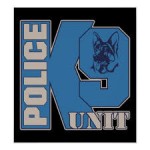 Veterinarians at Fort Belvoir in Virginia have kept a keen eye on working dogs — including those that watch over airports, the White House, the Capitol and other locations — for two decades. Routine preventive care as well as treatment for health problems are some of the issues addressed by veterinarian Nancy Vincent-Johnson and her colleagues at the clinic.
Veterinarians at Fort Belvoir in Virginia have kept a keen eye on working dogs — including those that watch over airports, the White House, the Capitol and other locations — for two decades. Routine preventive care as well as treatment for health problems are some of the issues addressed by veterinarian Nancy Vincent-Johnson and her colleagues at the clinic.
By Lori Aratani, for the Washington Post
The giveaway?
For more than 20 years, the squat, red brick building at Fort Belvoir is where the D.C. region’s law enforcement dogs — the ones who patrol airports, the Capitol, the White House and other high-profile locations — have been taken for care.
The region is home to one of the biggest concentrations of working dogs in the country, officials say. Canines from the Secret Service, the Transportation Security Administration, Amtrak and the U.S. Capitol Police come here for their yearly checkups. The dogs are a variety of breeds — German shepherds, Labrador retrievers, Belgian Malinois, even beagles.
“I have nothing but good things to say,’’ said Sgt. Kevin Murphy, who heads the Metropolitan Washington Airports Authority’s K-9 Unit at Dulles International Airport. “They help keep our dogs healthy.”
During the swelter of Washington’s summer, clinic workers have traveled to Dulles to conduct special sessions on spotting heatstroke and exhaustion. During the winter, handlers may receive training on spotting frostbite and hypothermia.
Belvoir’s veterinarians, a mix of civilian and military personnel, understand the special needs of their patients. These working dogs may suffer from ailments not necessarily seen in their civilian counterparts. Sometimes it’s back trouble from all their leaping into trucks and cargo hatches. Their joints can suffer strain from the same jumping. Hip dysplasia — a condition caused by improperly formed hip joints — is another common ailment.
And like the jobs held by people, the dogs’ work can be stressful, with long hours and large crowds, said veterinarian Nancy Vincent-Johnson, a 21-year Army veteran who retired and rejoined the clinic as a civilian.
Take Igor, a 9-year-old German shepherd who works for the Capitol Police. Vincent-Johnson said she had squeezed Igor, whose specialty is explosives detection, in between appointments because he has been having intestinal issues. His weight is down, and his handler says Igor — Iggy to his intimates — is just not himself.
Vincent-Johnson strokes Igor’s rich black and brown coat as she examines him, feeling the area around his rib cage and gently lifting his impressively large paws. Igor stands patiently as she moves her stethoscope along his midsection and his handler summarizes the shepherd’s symptoms.
“Maybe the food he’s on is too rich,” Vincent-Johnson theorizes. She consults Igor’s chart and notes that blood work done during his previous visit indicated a Vitamin B12 deficiency, which can lead to a type of anemia that brings on weakness and fatigue.
The poking and prodding complete, Igor settles on the floor and lets out a deep sigh.
The doctor prescribes special food for dogs with intestinal issues and a series of shots to help with the B12 deficiency.
There is now good news: Igor has put on weight — six pounds since his last visit — so the hope is that whatever is ailing him will soon be cured.
Igor’s handler leaves the office with a large bag of dog food and several bottles of medicine. Igor gets a doggie treat as a reward.
One room away, the doctor’s next patient waits with his handler, Inspector Alexandra Hassler. Upton is a TSA dog specializing in passenger screening and experienced in sniffing out explosives.
The 4-year-old black Labrador is here for the first of two physicals he’ll have this year. As part of that, Vincent-Johnson will run him through a full exam, testing his peripheral vision by waving her hands at the side of his head, eyeing his gait as he walks down the sidewalk and drawing blood for a full screening.
“His ears look good,” she says. Upton is an enthusiastic patient, eager to sniff and show approval by licking the doctor’s arm. His friskiness belies his status as one of the oldest of the TSA dogs working at Dulles. He’s also observant: Only a few minutes into the exam, he’s figured out that on the shelf that holds the jars of tongue depressors and cotton balls is one that holds crunchy treats. He can’t take his eyes off the shelf.
Vincent-Johnson says Upton is healthy. The one exception: his left back teeth. “He may need some dental work,” Vincent-Johnson tells Hassler.
Finally, Upton’s enthusiasm is rewarded. A treat flies through the air and disappears into his mouth.


Leave a Reply